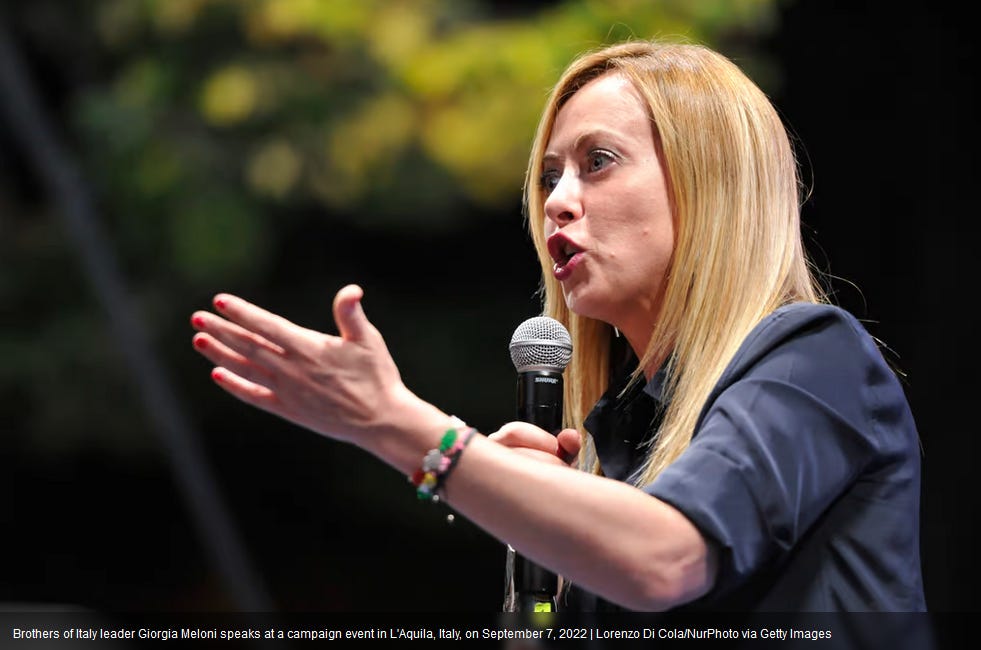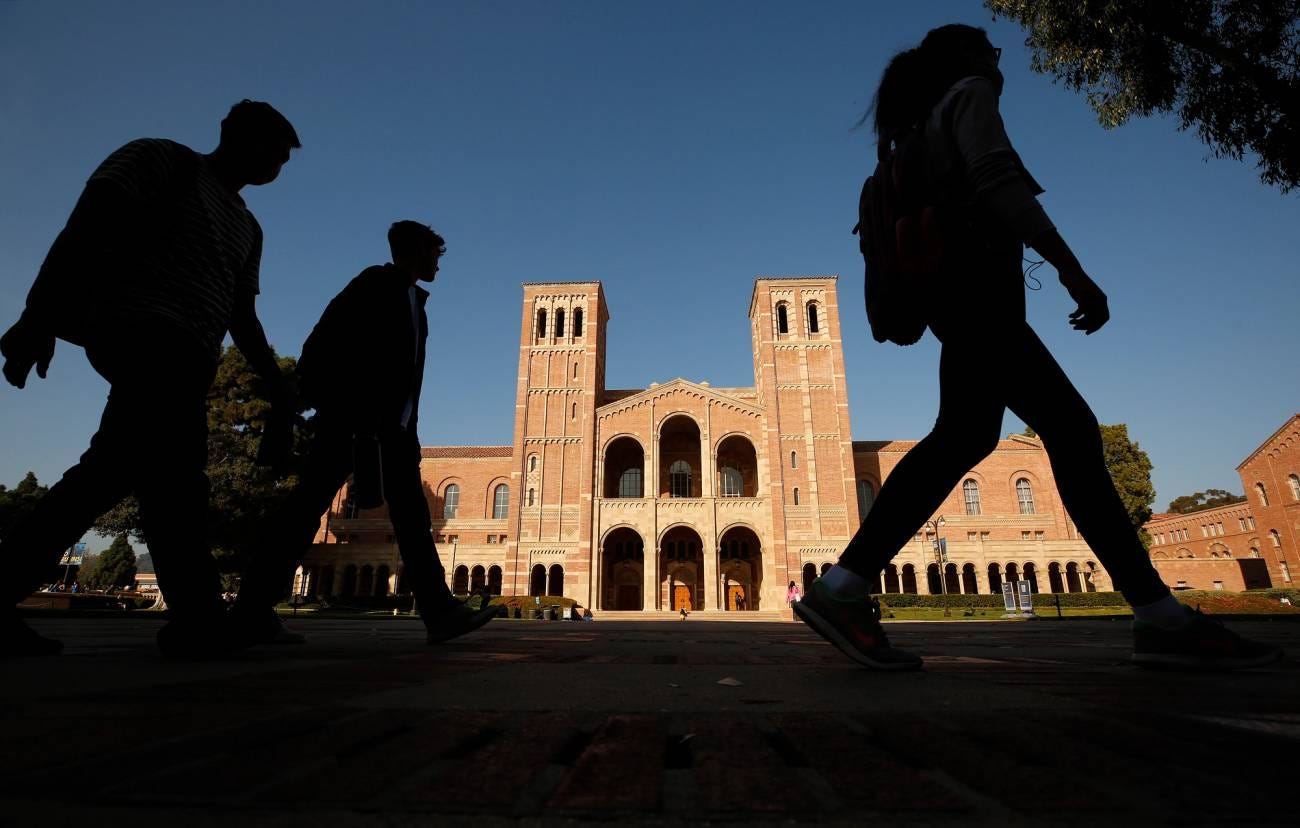Saturday Commentary and Review #98
Hungary as "Electoral Autocracy", Giorgia Meloni on Cusp of Power in Italy, America's Disappearing Middle Classes, "Wokeness Loyalty Oaths", Re-assessing the 60s TV Show "The Prisoner"
There is a growing sense of déjà vu in parts of Central and Eastern Europe these days. Poland, which has taken in millions of Ukrainian refugees while serving as the key rampart in the American-led conflict against Russia is being continually squeezed by both the US State Department and the EU over what they refer to as “the rule of law”. The Poles, jealously guarding their national sovereignty (and with good reason), are receiving no grace whatsoever from their allies. They are being pressured to conform to the dictates of western liberal democracy.
Hungary is in a weaker position than the Poles vis-à-vis Washington and Brussels, with the government in Budapest long being the target for soft regime change due to Fidesz’s rejection of opening its borders to migrants, and some ‘stuff’ about “rule of law” and “media”. The Magyars refuse to conform to the dictates of western liberal democracy, which means that punishment will continue until they do so.
This past week, the European Parliament voted in an act of symbolism to brand Hungary as “no longer a democracy”, adding that “European values are under systemic threat” in that country. This assembly reached the conclusion that the Pannonian country is an “electoral autocracy”. This vote, even if toothless, will now inform the EU Council in its continuing conflict with Budapest.
Once again Magyars are being told by foreigners how to run their own affairs. This isn’t 1956; no soldiers are going to occupy Budapest and no intelligence service will be hunting down Magyar patriots in the streets to hang them on lampposts. In a different way what is happening now is actually worse: purported democratic bodies are dictating to Hungarians how to run their country in the name of democracy, while rejecting the democratic will of the Magyars themselves. National sovereignty is a touchy subject not just in Warsaw, but in Budapest too.
Sohrab Amari recently sat down with Viktor Orban to share his side of the story with western readers:
But in the case of Russian energy, the sanctions were always structurally bound to backfire against Europe.
“If someone believes you can beat Russia, and change things in Moscow, it is a pure mistake,” Orbán told his party’s grandees in Kötcse, speaking forthrightly about the war’s military endgame.
His attitude isn’t born of any deep love for Moscow—impossible, given half a century of Soviet occupation and the premier’s belief that Russian civilization is fundamentally different from Europe’s. Rather, it comes from the realism and cold rationality that Hungary’s historical and geographic circumstances have imposed on her.
Realism: The Russians have utterly confounded the energy sanctions’ intended effects, whether by selling their reserves to the Chinese, who then resell to the Europeans at a markup, or by simply selling less of the stuff at higher prices created by sanctions. In the event, the war and the sanctions have buoyed the ruble to historic highs.
Realism: Seeking to beggar their giant neighbor to the east, the Europeans have beggared … themselves. Fuel lines are now a common sight in Poland and elsewhere. Manufacturers have shuttered production in Germany and across much of Northern Europe. Energy bills are already unsustainable for British small businesses, and winter isn’t even here yet.
Realism: Central and Eastern Europe, Hungary very much included, risk serious developmental backsliding, just when the region is poised to become a net contributor to the EU budget. As Orbán said to me, “the war and the sanctions prosecuted by the West will cause the region to lose all the gains it’s made relative to Western Europe.”
more
All this raises a vexing question for American policymakers—at least those willing to listen, rather than mindlessly dismiss Orbán as “illiberal.” Is the United States really prepared to see Europe turn itself into an energy and economic basket case for no tangible gains against Moscow? Would it be desirable for millions of German workers laboring in high-end manufacturing to join jobless rolls? Is mass Polish poverty worth appeasing Warsaw’s insane and hopeless determination to fight an apocalyptic war against Russia on Ukrainian soil?
My readers know that my answer to this from day one of this war was an emphatic “yes!”.
Orban agrees:
The most cynical Hungarian answer is that that is exactly what Washington wants to bring about: to downgrade German manufactures and sever the energy-manufacturing synergy between Russia and Germany, to end Europe’s aspirations to “strategic autonomy” and induce a total dependence on America, and ultimately to reduce the number of America’s industrial rivals from two (China and Europe) down to one (just China).
Europe has been turned into a collection of US states, but without any representation in Congress.
The Hungarians cannot make Europeans grow a backbone: even the Hungarians together with the Poles don’t have the collective weight to do so. This bodes ill for the continent.
We all (rightfully) cheered 1989 and the collapse of the Eastern Bloc. We went on to learn that the interpretation regarding what happened that year was very different in the eyes of Western Europe and those in the newly-freed former Eastern Bloc. Western leaders viewed it as the desire of Europeans to gain the same individual rights and liberties that they already enjoyed. In the former Soviet satellite states, national liberation was the key driver. This disconnect is what drives these present internal EU conflicts.
People increasingly ask me for my view on FdI’s leader Giorgia Meloni. I don’t have one. She’s an unknown quantity, and we have to wait and see how she will perform as Italy’s first female Prime Minister. The only insight that I’ve received regarding her is that northerners snobbishly do not like her southern (Roman) accent.
Italy’s parliamentary elections are being held next Sunday, and a centre-right coalition is slated to win, with Meloni’s FdI (Brothers of Italy) slated to finish first in the vote tally by a wide margin. This ensures that she will indeed become the Prime Minister. What she will do while in office will entirely be up to her, with readers of this Substack fully aware of the suspicions surrounding her and her intentions.
English-language western media thus far has been playing a wait-and-see game as well despite having the heavy artillery to launch repeated attacks against her for leading a party that has its roots in post-war Neo-Fascism. Politico gives us a taste of where attacks will come from should editors decide to begin firing:
So far, the results seem popular enough. L’Aquila has been governed by a Brothers of Italy mayor since 2017 and he was reelected in June, winning 54 percent of the vote in the first round.
Meloni told the crowd that she had chosen to run in this city as its candidate for parliament because she sees the region as “a symbolic territory” for her party. “This is the first land we governed and the symbol of our good governance … This is how we want to govern Italy.”
According to those gathered at the rally, the Brothers have demonstrated their competence in response to two major crises in the region: the coronavirus pandemic and ongoing reconstruction needs after an earthquake in 2009, which killed more than 300 and left 60,000 homeless. Locals also praised the authorities for securing a recent visit by the pope.
Antonio Pace, a shepherd turned policeman, backed Meloni and criticized the way the left-wing authorities handled the aftermath of the earthquake. “If the right hadn’t got in, we would still be living in containers,” he said.
Giacomo Soccorsi, a fireman, said he had come to see Meloni speak to decide whether to vote for her. “Since the right came in, the city is better every year. The building sites are working and the city has come alive again.”
Locals seemed to like Meloni’s authenticity and working-class credentials, noting her “grit,” the fact she speaks plainly and shows determination. According to a recent poll by GDC Sondaggi, 25 percent of voters in Abruzzo plan to vote for Brothers of Italy.
FdI won the Abruzzo region in the previous regional elections, and have governed it ever since. On the national stage, Meloni has kept FdI out of government, earning her and her party both populist and anti-establishment support:
“For a decade, Meloni stayed out of government and never got her hands dirty in coalitions,” said Testa. “More recently, she has reinvented herself as conservative instead of Euroskeptic, by supporting NATO and collaborating with Draghi and this has helped her gain the support of more sophisticated voters.”
Criticism:
But not everyone thinks Abruzzo is a good template for Italy. In reality, it ranked as the ninth-worst region for the number of COVID-19 deaths per head of population and fared worse than comparable central regions such as Marche and Umbria. Opponents complain that health care is increasingly in the hands of private enterprise while the rights of women and minorities have been undermined.
At both the city and regional levels, the Brothers have adopted measures that make it harder for migrants to access social housing. This is a point of pride for the party. “Thanks to Brothers of Italy, in Abruzzo the fast track for foreigners for social housing has been eliminated,” Meloni wrote in 2019. “Italians first is not just a slogan.”
Activists also took legal action against the city of L’Aquila after it refused food vouchers to immigrants during the pandemic.
more:
Campaigners are also concerned that the local authorities’ policies weaken women’s reproductive rights.
The region’s health authority has ignored national government guidelines that allow women to obtain a pharmaceutical abortion without a hospital stay. Then last year, three regional Brothers of Italy politicians proposed a law to bury aborted fetuses in a cemetery, even without a request from the woman.
According to activists, enforced hospital stays prevent some women from getting abortions as they may have to take time off work, or arrange child care, while the creation of cemeteries for aborted fetuses is intended to shame women who abort.
Sara Marcozzi, a regional councilor in the centrist Impegno Civico grouping, successfully opposed the proposals for such a cemetery. In Abruzzo, one doesn’t breathe fascism in the air, she said, but this proposal “smelled of fascism.”
A Nigerian gentleman weighs in:
Patrick Guobadia, an activist for immigrant rights in Abruzzo of Nigerian origin, said that Abruzzo is not a racist place, but “where the right govern in Italy, immigrant issues are second place. We know they don’t want immigrants in Italy.”
Western liberal democracy informs us that the will of the people is undemocratic, and that countries must accept foreign diktaks because to do so is to be ‘democratic’.
For the US Fourth of July, I LARPed as Alexis de Tocqueville and wrote a piece entitled “On America”. I think it was half-decent, and many of you agreed with my assessment. A large portion of it was dedicated to older relatives of mine who emigrated to the USA in the 1950s where they did indeed realize “The American Dream”. Hard work and a bit of luck saw them make something of themselves that they couldn’t possibly do in the old country. Their lives got better, and the lives of their children were guaranteed to do so as well. “We will certainly live better than our parents did”, was the assurance.
Three generations later and the once-secure American middle class faces extinction, argues Joel Kotkin:
You can’t have a democracy—at least outside of a one-party “people’s” version—without a middle class. Much of the last half millennia is the story of the bumpy rise of an expanding middle class, which successfully replaced ancient aristocratic structures, creating a remarkably innovative economic culture and a vital democratic society. But over the last four decades, this class—which includes artisans, small businesspeople, and skilled workers—has been declining, largely as the result of economic forces but also because of political decisions to adopt policies inimical to those groups’ needs.
One sees this process unfolding in the wealth gap between the global rich and the middle class: it has grown to levels not seen since the dawn of the Industrial Revolution.[1] In many countries, the income gap between the top 1 percent of the population and the remaining 99 percent is at an all-time high.[2] This reality has been particularly marked in the United States. As one conservative economist put it succinctly in 2018, “The economic legacy of the last decade is excessive corporate consolidation, a massive transfer of wealth to the top 1 percent from the middle class.”[3] In the United States, an affluent class of roughly 1.35 million—the top 1 percent—is doing fine, but wealth gains have been especially concentrated among the top 0.1 percent, roughly one hundred and fifty thousand people.[4] Since the mid-1980s, the share of national wealth held by those below the top 10 percent has fallen by twelve percentage points, the same proportion that the top 0.1 percent gained.
Market efficiencies!
Flirting with neo-feudalism:
The key here is not a disproportion of wealth as a singular moral issue. It is not simply that some people are now wealthier than ever. Rather, it is that the wealthy are not only considerably more wealthy and more powerful, and that even (historically) comfortable and independent groups—the middle class and the upper end of the working classes—are being undermined and turned into serf-like dependents.
If these trends hold, we may witness the middle class and the aspirational working class being overwhelmed by the rise of a ruling coalition of oligarchs and a modern clerisy, with implications well beyond economic considerations. The rise of the middle class rested on a value structure built around religious faith, family, the rule of law, and respect for property rights. As this middle class, the yeomanry, fades, along with its value structure, we seem to be heading to an era of autocracy, intolerance, stagnation and control—a reversion, in some ways, to a new kind of feudalism.
(I don’t necessarily agree with this next excerpt in full, but will share it anyway for illustrative purposes):
At the root of this change was a shift from aristocratic and ecclesiastical domination of landownership to a more “individualistic” concept of property rights.[25] A substantial class of independent smallholders demanded a constitutional order that would protect their holdings.[26] Artisans and merchants had laid the groundwork for self-governance within their guilds and in some places seized power from the aristocracy and even the clergy. As the radical social theorist Barrington Moore said a half century ago, “no bourgeois, no democracy.”[27] Or, to alter Aristotle a little, no middle class, no political liberty.
The American Miracle:
As students of classical history, the founders of the American republic believed the dispersion of property was critical to democracy. Thomas Jefferson, James Madison, and John Adams all considered the overconcentration of property in few hands a basic threat to republican institutions, a view also embraced by thinkers like Edmund Burke, Alexis de Tocqueville, and Adam Smith.[29] When the Industrial Revolution was proceeding apace, Karl Marx declared the rising bourgeoisie to be “the first to show what man’s activity can bring about” by exchanging the veneer of religiosity and chivalry with “naked, shameless, direct brutal exploitation.”[30] But capitalism did not produce the dystopia that Marx predicted; instead it lifted up a large portion of the masses and created a solid middle class (a designation first used in Britain in 1812).[31]
Never before had so much prosperity and relative economic security been so widely enjoyed.[32] Between 1940 and 1950, the incomes of the bottom 40 percent of American workers surged by roughly 40 percent, while the gains in the top quintile were a modest 8 percent and the top 5 percent saw their incomes drop slightly.[33] Between 2005 and 2014, the percentage of families with flat or decreasing real incomes rose to over 60 percent in the twenty-five most advanced economies.
Kotkin on why the decline is is accelerating:
These remarkable achievements of liberal capitalism are now distinctly threatened. This is likely not a “conspiracy” but the collective result of private actions driven by rational decision-making.
Until the 1990s, fields that were growing and promised higher profits invited newcomers, as one would expect.[36] Since then, there has been a marked decrease in the percentage of all small firms in both the United States and Europe as larger firms continue to increase their share of the pie.[37] Technology has played a critical role by facilitating global commerce and, increasingly, driving business from the Main Streets and local companies to massive firms with the ability to adjust to changing conditions.[38]
This was particularly evident during the pandemic—made worse by the response to Covid and the Russo-Ukrainian War—stoking inflation to the highest level in forty years.[39] Roughly one hundred and ten thousand restaurants have shut down during the lockdowns, and some two hundred thousand more businesses overall have simply shut down.[40] It is no surprise that barely 16 percent of small business owners, according to one recent survey, think the federal government is performing well for them.[41] As executive compensation reached the stratosphere at the big tech and finance firms, the Harvard Business Review notes that small businesses—the bulwark of the yeoman class—face “an existential threat” to their existence.[42] The pandemic shift clearly favored big companies, who could deploy far greater resources make the necessary transition to the new reality. Big Pharma companies have reined in lucrative profits with vaccine revenue.
Bleak outlook:
This trend is also occurring in the United States, the historic heartland of middle-class aspiration. According to one study, the chances of middle-class earners moving up to the top rungs of the income ladder has declined by approximately 20 percent since the early 1980s.[54] Data from the census bureau show that the share of national income going to the middle 60 percent of households has fallen to a record low.[55] Wealth gains in recent decades have gone overwhelmingly to the top 1 percent of households, and especially the top 0.5 percent, as wage and salary income, starting in the early 1970s, have dropped as a percentage of wealth.[56]
Banking and finance, treated amiably by Washington during the financial crisis, have become increasingly concentrated, while many smaller regional institutions have either been acquired or driven out of business.[57] Growing corporate concentration has now seeped into the once dynamic tech economy in both the United States and Europe.[58] In Silicon Valley now, the renowned garage culture has morphed into a Gargantua of giant firms with market power unprecedented in modern times, controlling in some cases 80 to 90 percent of their markets.
I don’t agree entirely with Kotkin’s diagnoses, but the piece is a very interesting read nonetheless.
Almost two years ago now, I wrote “The Desquamation of America”. In this essay, I argued that the USA is morphing into a hybrid mercantilist-ideological state where “wokeness” serves as the ruling ideology.
It’s no secret to you readers that “wokeness” found its most fertile fields in US academia, using it as a base to spread into government and beyond. This is why it should come as no surprise to you that “woke loyalty oaths” are being tested out in academia now too.
In 2021, the Oregon Health and Science University (OHSU) School of Medicine—ranked fourth in the country for primary care—released a 24-page “Diversity, Equity, Inclusion and Anti-Racism Strategic Action Plan,” listing dozens of “tactics” for advancing “diversity and racial equity” over the ensuing half-decade. One of those tactics reads: “Include a section in promotion packages where faculty members report on the ways they are contributing to improving DEI, anti-racism and social justice.” The plan promises to “reinforce the importance of these efforts by establishing clear consequences and influences on promotion packages.”
OHSU’s policy represents the latest stage in the institutional entrenchment of DEI programming. Universities have long required diversity statements for faculty hiring—short essays outlining one’s contributions to DEI and future plans for advancing DEI. Since it began almost a decade ago, the policy has been criticized as a thinly veiled ideological litmus test. Whether you see it as one largely depends on whether you think DEI is simply a set of corporate “best practices” like any other, or constitutes a rigid set of political and social views. In any event, the diversity statements and criteria have only expanded, and are now commonly required for promotion, tenure, and faculty evaluation.
“We love the Party and the Party knows best.”
Examples are plenty:
At the University of Illinois Urbana-Champaign, applicants seeking positions in chemical and biomolecular engineering must submit a one-page “Statement describing candidate’s approach to and experience with diversity, equity, and inclusion in higher education.” At the University of Tennessee at Knoxville, despite a new law that prohibits requiring job applicants “to endorse a specific ideology or political viewpoint,” applicants for a job in political science must submit a “statement concerning experience with and plans for contributing to diversity, equity, and inclusion.” Meanwhile, every open faculty position listed by Ohio State University’s College of Arts and Sciences, including roles in econometrics, freshwater biology, and astronomy, requires some variation of a statement “articulating the applicant’s demonstrated commitments and capacities to contribute to diversity, equity, and inclusion through research, teaching, mentoring, and/or outreach and engagement.”
You will be scored on your enthusiasm:
Almost all of the publicly available rubrics used by recruitment search committees resemble the University of California, Berkeley’s “Rubric for Assessing Candidate Contributions to Diversity, Equity, Inclusion, and Belonging,” which dictates that applicants should receive a low score if they “[discuss] diversity in vague terms, such as ‘diversity is important for science,’” or if they “state that it’s better not to have outreach or affinity groups aimed at particular individuals because it keeps them separate from everyone else, or will make them feel less valued.”
The application of metrics to ideological conformity:
The rubric published by the University of Colorado Denver mimics parts of Berkeley’s rubric verbatim, but also takes it a step further: In one category, candidates receive a middling score for espousing the “golden rule” (“I will treat others as I want to be treated”) but the highest score for espousing the “platinum rule” (“I will treat others as they want to be treated”). Meanwhile, some institutions employ even more overtly ideological language. At Western Oregon University, high-scoring statements provide “at least two or more strategies for contributing to advancing racial equity and eliminating systemic racism” and identify “at least three inequities and … how they would address those inequities if employed at WOU.”
This poses a threat to academic freedom, of course.
Now check this out:
The Oregon Health and Science University School of Medicine was recently reaccredited, but the Liaison Committee on Medical Education (LCME), which accredits medical schools, found it lacking in faculty diversity. In response, the medical school released its DEI strategic plan, which was created “in alignment with accreditation requirements,” and which promises not only “consequences” for faculty who don’t get on board but also to “develop and incorporate DEI, anti-racism and social justice core competencies in performance appraisals of faculty and staff.”
Coercion.
There are no brakes on this train, despite what some liberals, moderates, and conservatives will have you believe.
We conclude this weekend’s Substack with a look back at the 1960s TV show “The Prisoner”, its cultural influences, and how it is tied to the CIA.
The cult TV series The Prisoner has retained cultural cache and prolonged interest since its debut in 1967. Combining surrealism and paranoia with the core theme of an individual trying to survive a sinister and mysterious technocracy, it is as prescient now as it was during the Cold War. The Prisoner was largely the brainchild of its protagonist, the esteemed Irish-American actor Patrick McGoohan. The aesthetics of the series would exert some influence on the British psychedelic scene and even the later Mod Revival as seen with The Times, “I Helped Patrick McGoohan Escape.”
Plastic_Khanate is an old friend of mine who has written some interesting and clever stuff over the years. I wish he’d write a lot more than he has thus far.
Thank you once again for checking out my Substack. Hit the like button and use the share button to share this across social media. Leave a comment below if the mood strikes you. And don’t forget to subscribe if you haven’t done so already.








Hit the like button and use the share button to share this across social media. Leave a comment if the mood strikes you (be nice!), and don't forget to subscribe if you haven't already done so.
IMPORTANT: please note that I have rolled out the "Threads" feature. This is a new feature that is for paid subscribers so that they may engage in more discussion than they already do. YOU WILL NOT RECEIVE EMAILS WHEN THREADS ARE POSTED, for the simple reason that I do not want to spam your inboxes.
This means that you will have to check the homepage of this Substack to see when new threads are posted.
Here's the link to the first one that went up yesterday - https://niccolo.substack.com/p/thread-001-lost-spanish-civil-war/comments
RE: Disappearing middle-class: Usually this is EXACTLY why you need a TRUE leftist movement. You know - a movement by and for workers, non-governmental organisations, etc. The biggest thing neo-cons were able to achieve, and I repeat this ad nauseam, is highjacking the left's whole platform and rapidly contort it into the IdPol pseudo-religion it is today. A true leftist (moderate at least) non-Idpol movement would make a huge splash in America's political life (it almost did during Occupy), and the elitist knew this, so they did everything in their power to terminally discredit "leftism" not as a movement of workers, the middle-class and yes, the actual intelligentsia, but a movement of profound moral depravity and woke fascism.